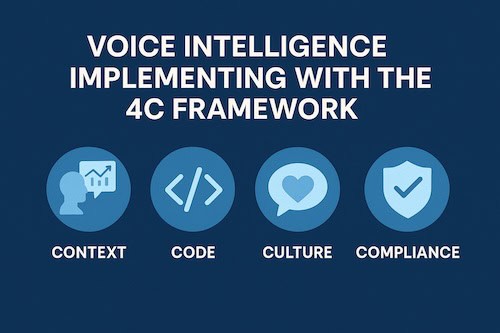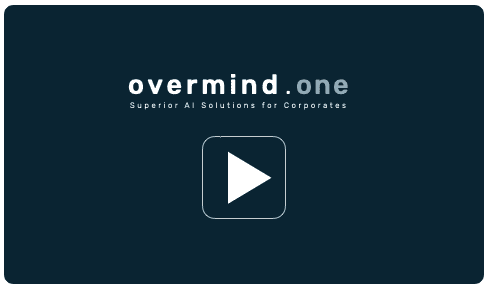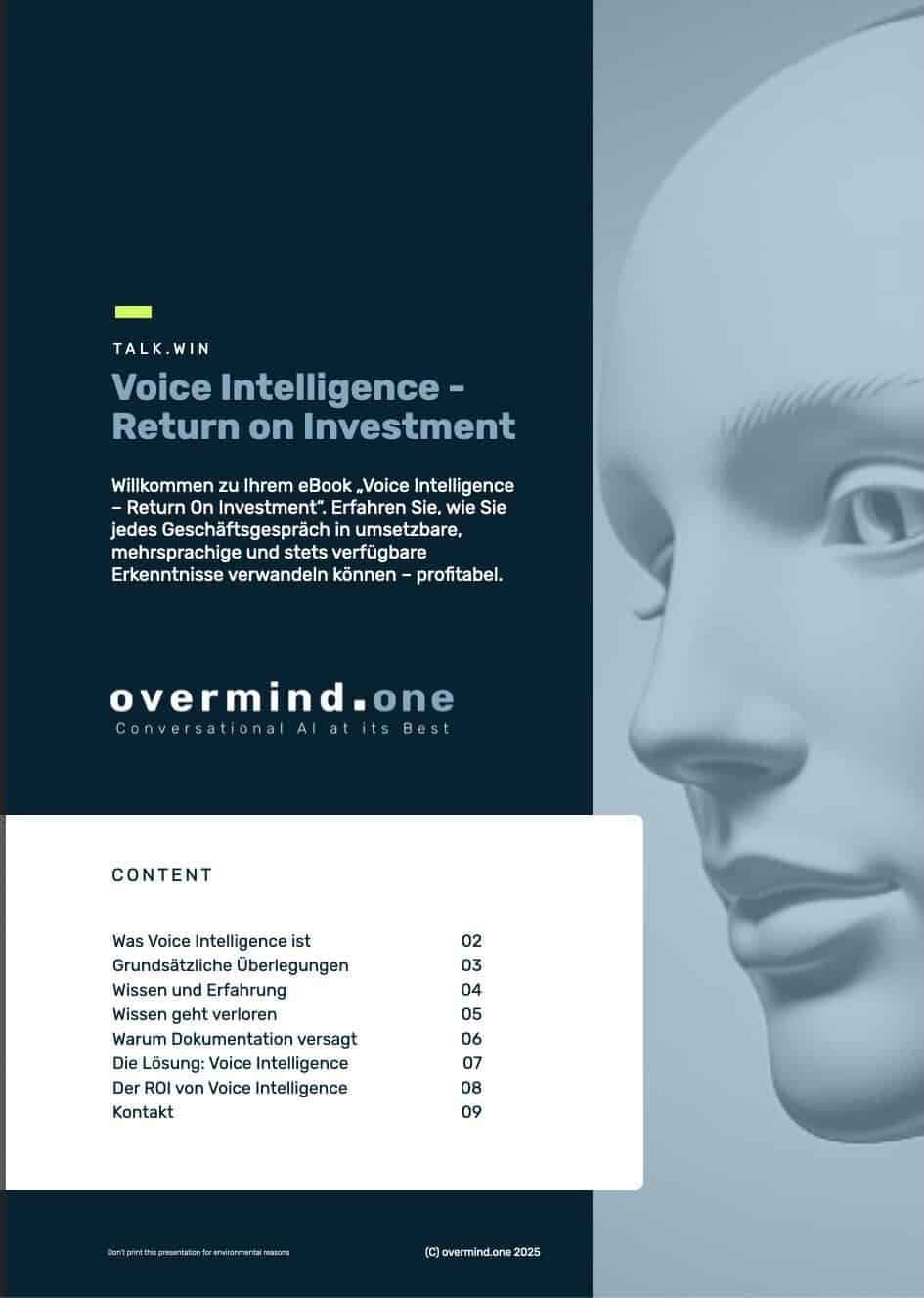Successfully implementing voice intelligence – why 4 C makes companies unbeatable
When people talk about artificial intelligence, many think of image recognition, text analysis, or data models. In doing so, companies often overlook one of the most immediate and human channels of all: the voice.
Language is not just communication—it is trust, closeness, and efficiency in its purest form. Voice Intelligence (VI) harnesses this power to seamlessly connect machines, processes, and people. It creates access to knowledge, simplifies work steps, and makes products and services more interactive. But one crucial question remains
1. Wie bringt man Voice Intelligence in Praxis?
How can voice intelligence be put into practice in a way that creates real added value—not just at some point in the future, but in a measurable and timely manner?
The answer is: with the 4C framework.
Many companies launch voice intelligence projects out of enthusiasm for new technology—and quickly find themselves at a dead end:
• Tools are implemented in isolation, without clear connections to existing systems.
• Content is incomplete or out of date.
• The brand voice is lost because no one cares about tonality and user experience.
• Data protection and compliance issues are raised too late and slow down the rollout.
The 4C framework avoids precisely these stumbling blocks. It offers a clear, practical roadmap that combines technical excellence, economic logic, and cultural fit. Instead of “technology for technology’s sake,” it creates an implementation that is scalable, ROI-driven, and legally secure.
2. How to get there: Potential analysis & ROI – before the 4 Cs take effect
Before building technology, you need to understand where it will make the biggest difference.
Potential analysis – making opportunities visible
Almost every company has language-intensive processes: customer service, consulting, field service, training, or onboarding. These often cost time and money or lead to knowledge loss.
A potential analysis reveals these hidden communication flows.
Examples:
• Service requests that repeatedly concern the same issues.
• Consultations in retail that depend on employees’ product knowledge.
• Training and induction processes that consume a lot of manpower.
Anyone who understands where language is expensive and slow today will quickly recognize where voice intelligence can ease the burden, speed things up, or even create new revenue opportunities.
ROI analysis – prioritizing economically
Not every good idea pays off immediately. That’s why an ROI assessment follows:
• How much do consulting, implementation, and licensing models cost?
• How much can you save or earn more through more efficient processes?
• Over what period of time will the project pay for itself?
Example: A voice bot that handles 30% of all standard inquiries can quickly save hundreds of hours of work in a service center and free up employees for more complex tasks. Such effects can be clearly calculated.
This results in a priority list that shows: Which use cases offer the greatest leverage in the short term? Which are long-term investments in competitiveness?
3. The 4 Cs in detail – the core of successful voice intelligence
After the analysis phase, things get concrete. The 4 Cs are the proven implementation framework that ensures that ideas are turned into functioning, economically viable solutions.
C1 – Context: Knowledge is power (and personalization is a must)
A voice solution is only as intelligent as the data it can understand and use.
• Data connection: CRM systems, service histories, product information, FAQ databases, internal guidelines—all of this provides context so that responses are accurate and personalized.
• Understanding the situation: Does a customer currently have an open ticket? Which products do they own? What is their service history?
Without context, a voice solution seems generic and impersonal.
With context, it becomes a true digital assistant that noticeably reduces people’s workload and strengthens customer relationships.
C2 – Code: The technological basis must be right
Even the best idea will fail if the technology does not function reliably.
• Speech recognition (ASR): Does the solution understand different accents, dialects, and technical terms?
• Natural language understanding (NLU): Can it correctly recognize intentions and process them accurately?
• Antwortgenerierung (LLM & TTS): Liefert sie natürliche, flüssige Sprache statt „Roboterstimme“?
• System integration: Voice intelligence only delivers real efficiency gains when it is seamlessly embedded in CRM, ERP, or other tools.
A solid technological foundation transforms a proof-of-concept into a scalable platform.

(C) 2025 Overmind.one
C3 – Culture: The brand must speak as it is
Technology is only half the battle. People want to interact with brands that feel genuine and familiar.
• Define the brand voice: Should the bot sound factual and serious, or relaxed and approachable?
• Consider cultural nuances: Dialects, multilingualism, regional idioms—all of these factors determine acceptance.
• Protect identity: An insurer speaks differently than a lifestyle brand; an industrial company differently than a retailer.
Culture ensures that voice intelligence comes across as authentic, builds trust, and strengthens brand perception.
C4 – Compliance: Trust is the currency of the future
In Europe in particular, data protection is not a “nice-to-have” but an obligation.
• Legally compliant data processing: The GDPR and AI Act define clear requirements.
• Security & access rights: Who is permitted to listen to, store, or delete voice data?
• Transparency: Users need to know what happens to their data.
Compliance is not only a shield against penalties, but also a strategic advantage.
Companies that take data protection and ethics seriously gain trust—both internally and among customers and partners.
6. Why the 4 Cs represent the best implementation methodology
Holistic: They combine business logic, technology, brand, and legal considerations.
Cost-effective: Decisions are made based on ROI and business value.
Scalable: Once established, new use cases can be added quickly.
Brand-aligned: AI does not sound like “a machine,” but rather like your own brand.
Future-proof: Regulatory requirements are taken into account from the outset.
Wer die 4 C konsequent anwendet, baut kein Experiment, sondern ein strategisches Asset, das messbaren Wert stiftet.

(C) 2025 Overmind.one
7. From pilot project to game changer – the roadmap
1. Identify potential – where language currently costs time and money.
2. Calculate ROI – what is worth doing first, what later.
3. Apply the 4 Cs – integrate context, code, culture, and compliance.
4. Launch pilot & scale – create quick wins, then grow.
This roadmap ensures that Voice Intelligence will not only remain an exciting innovation project, but will also be economically viable and sustainable in the long term.
Conclusion: Voice intelligence pays off—if you do it right
Voice intelligence has long been more than just a promise for the future. Today, it is a clear competitive advantage—if companies implement it in a structured manner.
The 4C framework is the key: it ensures that voice intelligence not only works technically, but also makes economic sense, fits in culturally, and is legally secure.
👉 Those who follow the path of the 4 Cs are not building a gimmick, but a sustainable value driver.
👉 Those who do not take it risk isolated solutions, frustration, and missed opportunities.
The voice is the most direct channel of communication—it’s time for companies to finally use it strategically.
Tip: Start with a potential analysis and ROI assessment to identify your greatest opportunities. Then, the 4 Cs bring structure and certainty to implementation—making voice intelligence a real game changer.

(C) 2025 Overmind.one





0 Comments